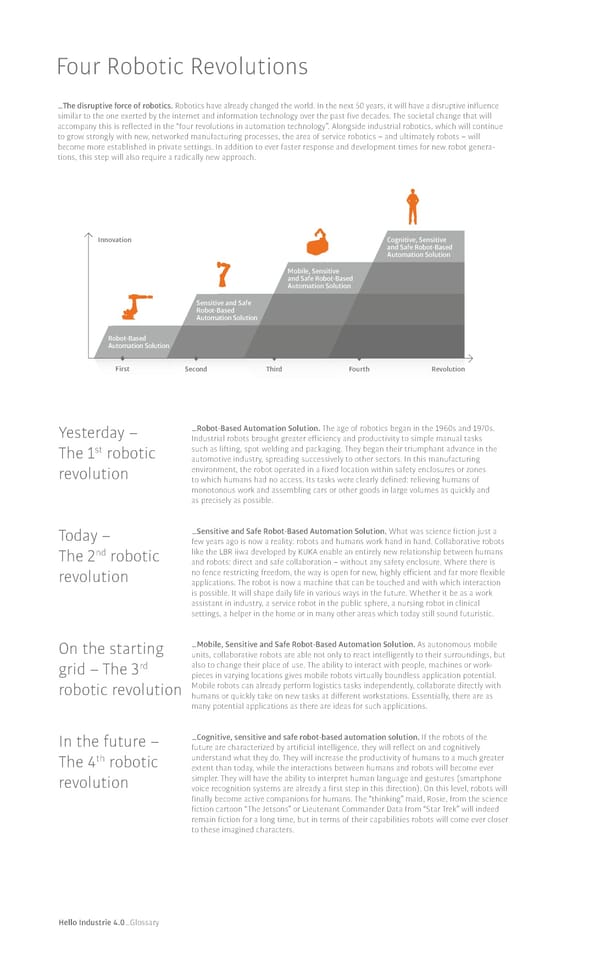Four Robotic Revolutions �The disruptive force of robotics. Robotics have already changed the world. In the next 50 years, it will have a disruptive in昀氀uence similar to the one exerted by the internet and information technology over the past 昀椀ve decades. The societal change that will accompany this is re昀氀ected in the “four revolutions in automation technology”. Alongside industrial robotics, which will continue to grow strongly with new, networked manufacturing processes, the area of service robotics – and ultimately robots – will become more established in private settings. In addition to ever faster response and development times for new robot genera- tions, this step will also require a radically new approach. Innovation Cognitive, Sensitive and Safe Robot-Based Automation Solution Mobile, Sensitive and Safe Robot-Based Automation Solution Sensitive and Safe Robot-Based Automation Solution Robot-Based Automation Solution First Second Third Fourth Revolution Yesterday – �Robot-Based Automation Solution. The age of robotics began in the 1960s and 1970s. Industrial robots brought greater e昀昀iciency and productivity to simple manual tasks st such as lifting, spot welding and packaging. They began their triumphant advance in the The 1 robotic automotive industry, spreading successively to other sectors. In this manufacturing revolution environment, the robot operated in a 昀椀xed location within safety enclosures or zones to which humans had no access. Its tasks were clearly de昀椀ned: relieving humans of monotonous work and assembling cars or other goods in large volumes as quickly and as precisely as possible. Today – �Sensitive and Safe Robot-Based Automation Solution. What was science 昀椀ction just a few years ago is now a reality: robots and humans work hand in hand. Collaborative robots nd like the LBR iiwa developed by 阀阀 enable an entirely new relationship between humans The 2 robotic and robots: direct and safe collaboration – without any safety enclosure. Where there is revolution no fence restricting freedom, the way is open for new, highly e昀昀icient and far more 昀氀exible applications. The robot is now a machine that can be touched and with which interaction is possible. It will shape daily life in various ways in the future. Whether it be as a work assistant in industry, a service robot in the public sphere, a nursing robot in clinical settings, a helper in the home or in many other areas which today still sound futuristic. On the starting �Mobile, Sensitive and Safe Robot-Based Automation Solution. As autonomous mobile units, collaborative robots are able not only to react intelligently to their surroundings, but rd also to change their place of use. The ability to interact with people, machines or work- grid – The 3 pieces in varying locations gives mobile robots virtually boundless application potential. robotic revolution Mobile robots can already perform logistics tasks independently, collaborate directly with humans or quickly take on new tasks at di昀昀erent workstations. Essentially, there are as many potential applications as there are ideas for such applications. In the future – �Cognitive, sensitive and safe robot-based automation solution. If the robots of the future are characterized by arti昀椀cial intelligence, they will re昀氀ect on and cognitively The 4th robotic understand what they do. They will increase the productivity of humans to a much greater extent than today, while the interactions between humans and robots will become ever revolution simpler. They will have the ability to interpret human language and gestures (smartphone voice recognition systems are already a 昀椀rst step in this direction). On this level, robots will 昀椀nally become active companions for humans. The “thinking” maid, Rosie, from the science 昀椀ction cartoon “The Jetsons” or Lieutenant Commander Data from “Star Trek” will indeed remain 昀椀ction for a long time, but in terms of their capabilities robots will come ever closer to these imagined characters. Hello Industrie 4.0�Glossary
 Embracing Industrie Page 101 Page 103
Embracing Industrie Page 101 Page 103